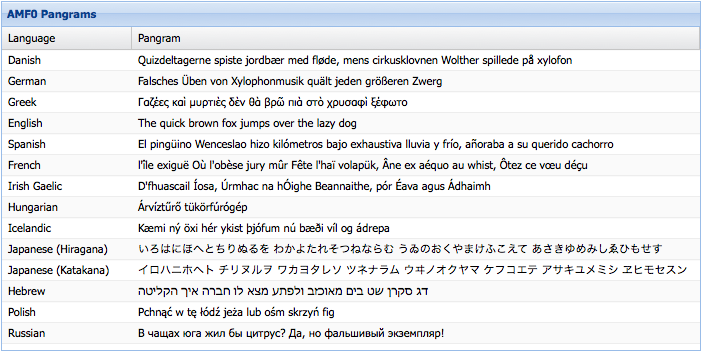Action Message Format (AMF) is a compact binary format used by Adobe Flash/Flex to serialize ActionScript object graphs. AMF is typically used to encode messages that are sent between an Adobe Flash client and a remote service. AMF is only a serialization technology, not a transport, so AMF encoded binary data can be used with any transport such as HTTP or HTTPS. This guide will show you how to use Ext JS and AJAX to consume AMF data sent over HTTP right inside a web browser, with no need for a Flash plugin. This guide assumes you are already somewhat familiar with the Ext JS Data package and Grid component.
Note: This functionality is only available with the purchase of Sencha Complete. For more information about using this class, please visit our Sencha Complete product page.
Working with AMF Packets
AMF-encoded object graphs are typically formatted as an “AMF Packet”. Multiple headers and messages are batched into a single AMF Packet. Lets take a look at how to use Ext JS to decode an AMF Packet and access its headers and messages. First lets make an AJAX request to a url that returns binary AMF Packet data.
Ext.Ajax.request({
url: 'some/url',
binary: true,
success: function(response) {
console.log(response.responseBytes);
}
});You should see a byte array in your console - either a Uint8Array if it is supported by your browser or just an Array of numbers. These are the raw bytes that compose the AMF Packet. It is important to remember to set the Ext.data.Connection#binary config to true on the AJAX request so that the response will be interpreted as binary data and the responseBytes property will be set on the response object.
Now that we have the raw binary data we need to decode it so that we can do something useful with it. To do this we use the Ext.data.amf.Packet class. Inside the success callback function add the following code to construct a new Packet:
var packet = Ext.create('Ext.data.amf.Packet');This gives us an empty AMF Packet object to work with. The Packet class contains all the logic required to decode the binary AMF-formatted data. To decode the AMF byte array, simply pass it to the Packet’s Ext.data.amf.Packet#decode method:
packet.decode(response.responseBytes);We now have a fully decoded AMF Packet. The decoded data can be accessed using the following properties on the packet object:
- Ext.data.amf.Packet#version - The Packet’s AMF version
- Ext.data.amf.Packet#headers - The Packet’s headers
- Ext.data.amf.Packet#messages - The Packet’s messages
Loading Records into a Grid
Now that we know how to use the AMF Packet, lets learn how to load some AMF-encoded records into an Ext JS Ext.data.Store using an Ext.data.amf.Proxy and Ext.data.amf.Reader and display those records in Ext.grid.Panel. In this example we will load records from an AMF Packet containing a list of pangrams in several languages. Start by defining the Ext.data.Model:
Ext.define('Pangram', {
extend: 'Ext.data.Model',
fields: [
{ name: 'language', type: 'string' },
{ name: 'text', type: 'string' }
]
});Next create a Ext.data.Store to contain the Model instances. Configure the store with an Ext.data.amf.Proxy. The AMF Proxy uses an Ext.data.amf.Reader by default so there is no need to explicitly configure the reader unless you need to change some of the reader’s default configurations.
var store = Ext.create('Ext.data.Store', {
model: 'Pangram',
proxy: {
type: 'amf',
url: 'some/url',
},
autoLoad: true
});Finally create a Ext.grid.Panel that is bound to the store we just created:
Ext.create('Ext.grid.Panel', {
title: 'AMF0 Pangrams',
height: 350,
width: 700,
store: store,
columns: [
{ text: 'Language', dataIndex: 'language', width: 130 },
{ text: 'Pangram', dataIndex: 'text', flex: 1 }
],
renderTo: Ext.getBody()
});
The above code makes some assumptions about where the raw record data are located within the packet. By default Ext.data.amf.Reader expects the Packet’s first message body to be an array of objects containing the record data. But this is not always the case - sometimes you need to tell the reader where to find the records in the message body. This is done using the reader’s Ext.data.Reader#root configuration property:
proxy: {
type: 'amf',
url: 'some/url',
reader: {
type: 'amf',
root: 'foo.bar'
}
}This tells the reader that the message body is an object containing a property named “foo” which is an object containing a property named “bar”, and the value of “bar” is an array of raw record data objects.
AMF Packets can contain multiple messages. You can configure which message the reader should look for the records in using the Ext.data.amf.Reader#messageIndex config:
reader: {
type: 'amf',
messageIndex: 42
}For a working example and full source code see AMF Grid Example
